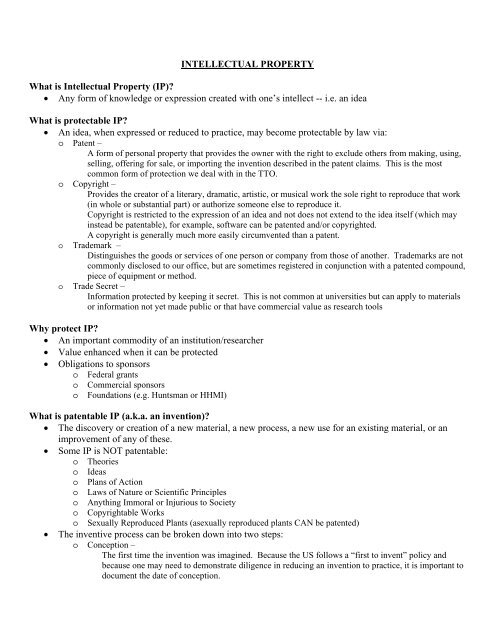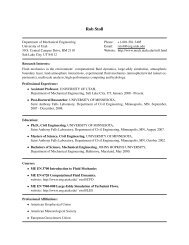University of Utah Technology Transfer Office Handout
University of Utah Technology Transfer Office Handout
University of Utah Technology Transfer Office Handout
Create successful ePaper yourself
Turn your PDF publications into a flip-book with our unique Google optimized e-Paper software.
INTELLECTUAL PROPERTY<br />
What is Intellectual Property (IP)?<br />
• Any form <strong>of</strong> knowledge or expression created with one’s intellect -- i.e. an idea<br />
What is protectable IP?<br />
• An idea, when expressed or reduced to practice, may become protectable by law via:<br />
o Patent –<br />
A form <strong>of</strong> personal property that provides the owner with the right to exclude others from making, using,<br />
selling, <strong>of</strong>fering for sale, or importing the invention described in the patent claims. This is the most<br />
common form <strong>of</strong> protection we deal with in the TTO.<br />
o Copyright –<br />
Provides the creator <strong>of</strong> a literary, dramatic, artistic, or musical work the sole right to reproduce that work<br />
(in whole or substantial part) or authorize someone else to reproduce it.<br />
Copyright is restricted to the expression <strong>of</strong> an idea and not does not extend to the idea itself (which may<br />
instead be patentable), for example, s<strong>of</strong>tware can be patented and/or copyrighted.<br />
A copyright is generally much more easily circumvented than a patent.<br />
o Trademark –<br />
Distinguishes the goods or services <strong>of</strong> one person or company from those <strong>of</strong> another. Trademarks are not<br />
commonly disclosed to our <strong>of</strong>fice, but are sometimes registered in conjunction with a patented compound,<br />
piece <strong>of</strong> equipment or method.<br />
o Trade Secret –<br />
Information protected by keeping it secret. This is not common at universities but can apply to materials<br />
or information not yet made public or that have commercial value as research tools<br />
Why protect IP?<br />
• An important commodity <strong>of</strong> an institution/researcher<br />
• Value enhanced when it can be protected<br />
• Obligations to sponsors<br />
o Federal grants<br />
o Commercial sponsors<br />
o Foundations (e.g. Huntsman or HHMI)<br />
What is patentable IP (a.k.a. an invention)?<br />
• The discovery or creation <strong>of</strong> a new material, a new process, a new use for an existing material, or an<br />
improvement <strong>of</strong> any <strong>of</strong> these.<br />
• Some IP is NOT patentable:<br />
o Theories<br />
o Ideas<br />
o Plans <strong>of</strong> Action<br />
o Laws <strong>of</strong> Nature or Scientific Principles<br />
o Anything Immoral or Injurious to Society<br />
o Copyrightable Works<br />
o Sexually Reproduced Plants (asexually reproduced plants CAN be patented)<br />
• The inventive process can be broken down into two steps:<br />
o Conception –<br />
The first time the invention was imagined. Because the US follows a “first to invent” policy and<br />
because one may need to demonstrate diligence in reducing an invention to practice, it is important to<br />
document the date <strong>of</strong> conception.





